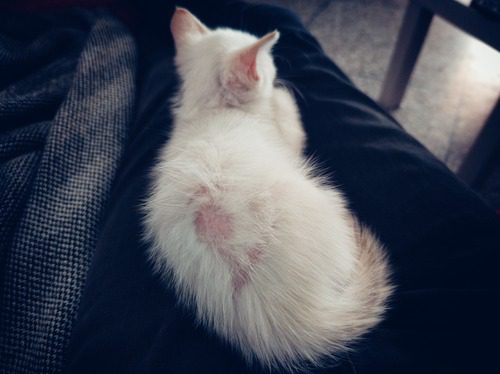Hair loss in cats, also known as alopecia, can be frustrating and concerning for pet owners. Whether the shedding seems excessive or you’re noticing bald patches, the question “Why is my cat losing hair?” often signals that something deeper is going on. Cats are generally excellent groomers, so visible changes to their coat can be one of the first signs that something’s off. While some shedding is normal, unexpected or unusual hair loss may point to underlying medical or behavioral issues. If your cat is suddenly balding or scratching excessively, it’s a good idea to bring them in for a full evaluation. Bayshore Veterinary Hospital in Holmdel, NJ is here to help. Call us at (732) 671-3110 to schedule a visit.

Normal Shedding vs. Abnormal Hair Loss
Cats shed to get rid of old or damaged hair, and in many cases, shedding increases during seasonal changes. That’s perfectly normal. However, if you’re finding clumps of hair around the house or your cat is developing thin spots or bald patches, the situation warrants a closer look.
Signs of Problematic Hair Loss
Healthy shedding happens gradually and affects the entire coat. The fur should still appear full and soft. Abnormal hair loss, on the other hand, can create uneven areas, scabs, redness, or signs of irritation. These changes could be your cat’s way of telling you something’s wrong.
Overgrooming and Hair Loss Patterns
Cats who lick, bite, or scratch excessively may cause their own hair loss through overgrooming. In those cases, the hair loss pattern tends to look symmetrical. If you’re asking, “Why is my cat losing hair in specific spots?”—such as the belly, legs, or near the tail—it may relate to stress, allergies, or medical issues. If you’re noticing this kind of hair loss, contact Bayshore Veterinary Hospital to schedule an exam.
Common Causes of Hair Loss in Cats
Several different factors can lead to this issue, including medical conditions, skin problems, parasites, and behavioral changes. Let’s explore some of the most common reasons.
Fleas and Other Parasites
Fleas are one of the most frequent causes of hair loss in cats. Even indoor cats can get them. A flea infestation doesn’t always appear obvious to the eye—especially if your cat is excellent at grooming. Still, the allergic reaction to flea saliva can cause intense itching, redness, scabbing, and hair loss. This condition is called flea allergy dermatitis. Other external parasites like mites (causing mange) or lice can also trigger similar symptoms. These tiny pests irritate the skin, making your cat scratch and overgroom, which leads to hair thinning or bald patches.
Allergies
If you’re wondering “Why is my cat losing hair around the neck or belly?”, allergies may be the culprit. Cats can develop allergic reactions to food ingredients, environmental allergens like pollen or mold, or materials they come into contact with—like certain types of bedding or cleaners. Allergies often cause itching, skin inflammation, and secondary infections. Over time, this discomfort can lead to overgrooming and hair loss, particularly in areas that are easier for cats to reach. Pinpointing the source of an allergy takes time, and it requires guidance from your veterinarian.
Skin Infections
Bacterial or fungal infections can also cause hair loss. Ringworm, a common fungal infection in cats, creates circular patches of hair loss that often appear red or scaly. Despite its name, ringworm isn’t caused by a worm—it’s a contagious fungus. Bacterial infections might develop as a result of other skin issues, such as bites or scratches, or from excessive grooming. If left untreated, these infections can worsen and cause widespread hair loss.
Hormonal and Metabolic Conditions
Sometimes, hair loss in cats relates to internal imbalances rather than external irritants. Hormonal changes can interfere with normal hair growth and lead to visible changes in your cat’s coat.
Hyperthyroidism
Hyperthyroidism is a common condition in older cats where the thyroid gland produces too much hormone. This overproduction affects many body systems and can lead to weight loss, increased appetite, and changes in the skin or coat—including hair thinning or patchy loss.
Other Hormonal Disorders
Less commonly, conditions like Cushing’s disease or diabetes can also cause skin changes and hair loss. These disorders often come with other noticeable signs such as increased thirst, changes in appetite, or lethargy. If your cat’s hair loss appears alongside behavioral or physical changes, it’s best to schedule a full exam. Bayshore Veterinary Hospital offers in-house diagnostics to help identify internal causes of hair loss. If you’re still asking yourself, “Why is my cat losing hair?”, don’t wait—call (732) 671-3110 to schedule a visit today.
Behavioral Causes of Cat Hair Loss
Hair loss isn’t always caused by a physical health issue. In some cases, it’s the result of stress, anxiety, or compulsive grooming habits. Behavioral causes of hair loss can be harder to detect, but they’re just as important to address.
Stress and Overgrooming
Cats often groom to self-soothe, but when grooming becomes excessive, it can damage the skin and thin the fur. This condition is known as psychogenic alopecia. It typically affects areas the cat can easily reach—like the belly, flanks, or legs. Common stressors include changes in the home environment, new pets or people, loud noises, or changes in routine. Identifying the source of stress can take time, and it may require behavior modification or environmental adjustments.
Boredom or Lack of Enrichment
Cats that don’t have enough mental or physical stimulation may begin grooming as a way to fill time or cope with boredom. This can lead to patterns of behavior that result in hair loss. Providing enrichment, playtime, and interactive toys can help reduce overgrooming, but it’s also important to rule out any medical causes first.
When to Call Bayshore Veterinary Hospital
If you’ve been wondering, “Why is my cat losing hair?” and haven’t found a clear answer, it’s time to get professional input. A thorough veterinary exam is the first step in identifying the cause and developing a treatment plan. During your visit, our team may perform skin tests, blood work, or parasite screenings to determine what’s affecting your cat’s coat.
Cats rarely show discomfort in obvious ways, so changes to the skin or coat can be an early warning sign. The sooner you bring your cat in, the sooner your veterinarian can help relieve their discomfort and begin the right course of treatment. For pet parents in Holmdel, NJ, Bayshore Veterinary Hospital can help. Call (732) 671-3110 to book your appointment and get the answers your cat needs.
